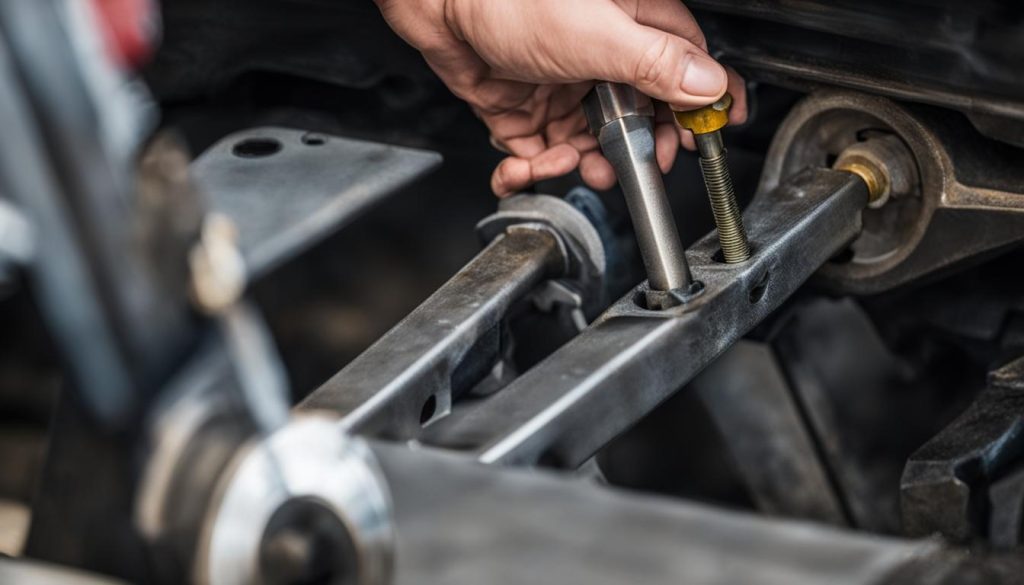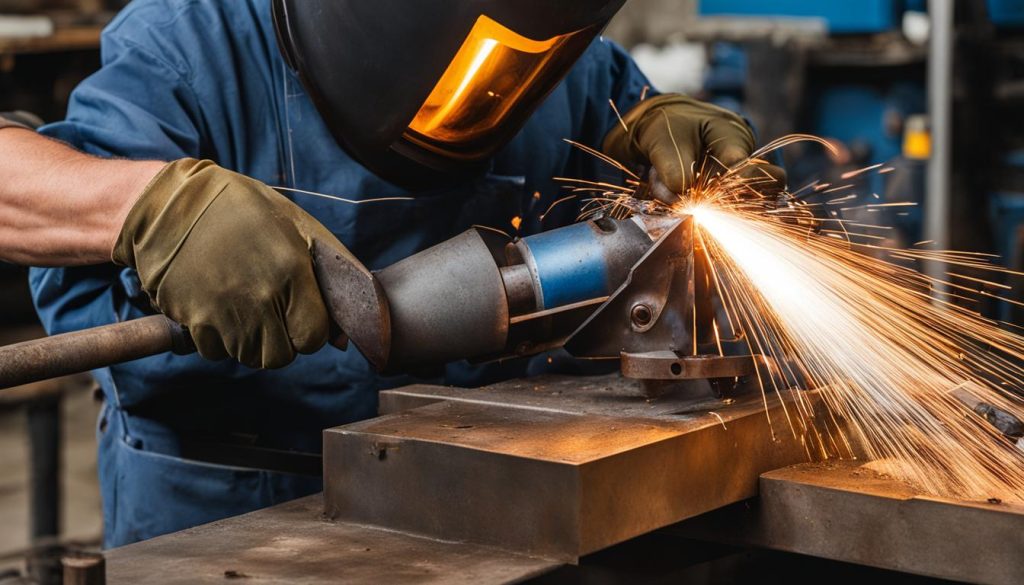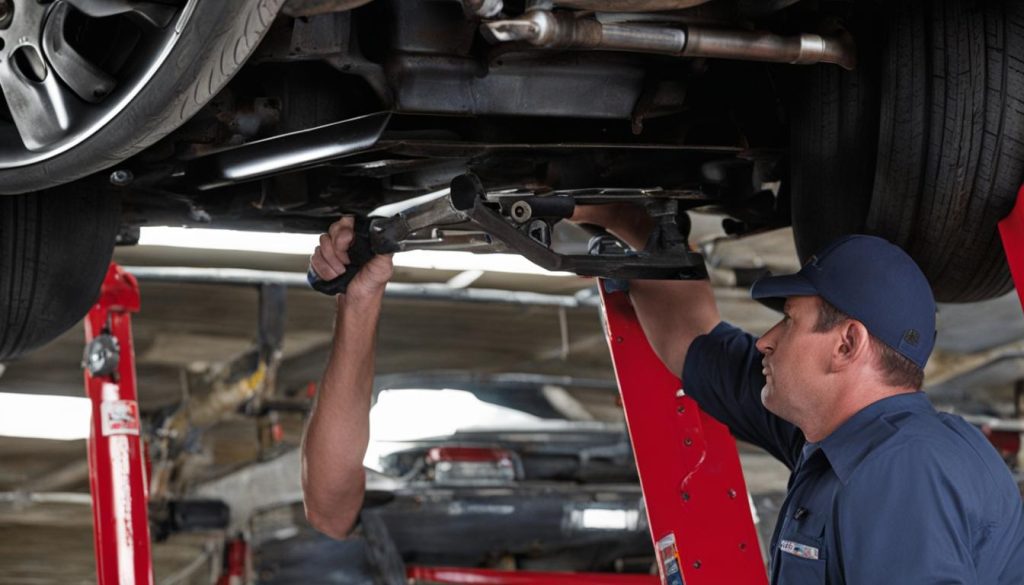DIY Traction Bars: Enhance Your Ride’s Grip
Are you enthusiastic about drag racing or eager to enhance vehicle grip on your ride? Crafting DIY traction bars may be the ideal project for you. By installing these bars, you’re not only investing in better traction and stability for your car but also delving into a gratifying and empowering upgrade.
Key Takeaways
- Building DIY traction bars contributes significantly to enhanced grip and a more stable driving experience.
- Improved traction helps prevent wheel hop and reduces torque steer, which are common problems in power-intensive driving scenarios.
- Using parts from renowned brands like Summit Racing and Aluminum Spacers assures quality and reliability in your do-it-yourself endeavor.
- Custom traction bars are cost-effective and can achieve results similar to high-end commercial products like APE traction bars.
- Assembly and installation of the bars is straightforward and does not require extensive mechanical expertise.
- The project is not only about practical benefits but also offers a sense of accomplishment and a deeper connection with your vehicle.
Whether your vehicle is a daily driver or a dedicated racer, adding do-it-yourself traction bars will lead to a notable improvement in handling sharp turns and maintaining grip during high-octane moments. With an easy-to-follow guide, the process of creating your own traction bars can be simple and rewarding, even if you’re new to the world of automotive DIY endeavors.
Let’s dive into this transformation journey where you’ll learn how to put together custom traction bars using high-quality components from trusted sources like Summit Racing and Aluminum Spacers. As you progress, you’ll uncover the secret to reducing, if not eliminating, the concern of wheel hop, and decreasing the unwanted torque steer that often comes with increased horsepower.
Get ready to embrace the road like never before, and turn your vehicle into the ultimate ride with optimized grip and performance!
An Introduction to DIY Traction Bars and Their Benefits
If you’re in pursuit of superior vehicle performance, building traction bars for your ride can bring significant advancements. Created as an affordable alternative to off-the-shelf solutions, DIY traction bars mirror the efficacy of renowned brands like APE traction bars, but are tailored to suit your personal automotive preferences and budget.
Embarking on the journey to construct your own traction bars not only equips you with a valuable skillset but also imparts enhanced control over your vehicle’s dynamics. A traction bars step-by-step guide enables enthusiasts like you to transform theory into practice, optimizing your vehicle’s grounding with the tarmac during bursts of power or in tricky cornering scenarios.
Let’s break down the key traction bar benefits:
- Traction bars are your ally against pesky wheel hop, the dreaded phenomenon that plagues many spirited drivers when accelerating. Textbook wheel hop can sap the joy out of your driving experience, leading to potential mechanical concerns down the line.
- Another critical advantage is the notable diminished torque steer. Especially in front-wheel-drive configurations, this can be a game-changer, offering you a smoother and controllably linear surge forward, without the tug-of-war on the steering wheel.
- A smoother ride is on the horizon with DIY traction bars. Whether it’s a leisurely cruise or a spirited drive, well-built traction bars ensure that your ride remains composed and unwavering.
- Not only do traction bars strengthen the bond between car and road, they also ensure better handling, granting a more dialed-in and precise response to your inputs, be it during aggressive launches or while negotiating tight bends.
| Feature | Benefit |
|---|---|
| Reduced Wheel Hop | Improved acceleration and safety |
| Decreased Torque Steer | Enhanced straight-line stability |
| Smoother Ride Quality | Increased comfort for daily driving |
| Better Handling | Sharper turns and robust vehicle control |
As you embark on the endeavor of building traction bars, envision the end result: a vehicle that responds to your every command with poise and certainty. With your bars in place, each drive transforms into a statement of precision and finesse. So roll up your sleeves and prepare to embark on a DIY journey that not only enhances your vehicle’s capabilities but solidifies your bond with your trusted steed.
Essential Components and Where to Get Them
When embarking on creating homemade traction bar plans, it’s pivotal to source high-quality parts that ensure durability and performance. By selecting precision-engineered components, you can construct custom traction bars that rival professional-grade equipment. Here’s a detailed configuration of the essential parts needed to construct homemade traction bars for trucks and how they function.
Keyser Manufacturing Brake Strut Rod Brackets
Finding the right brackets is crucial, and The Brake Strut Rod Brackets from Keyser Manufacturing stand out for their strategic design. Their angled construction ensures they deflect upon ground contact, a key detail when you expect your build to encounter tough terrain. Their design is tailored to seamlessly align with your vehicle’s subframe contours, facilitating efficient welding and installment.
QA1 Rod Ends and Jam Nuts
QA1 PCM Series Rod Ends and Jam Nuts are indispensable when it comes to connecting the dots within your custom traction bars components. Optimal performance hinges on a stable connection, and these components—celebrated for unparalleled adjustability—grant you precise control over the alignment. They deliver the robustness required for maintaining a firm seated position of the traction bars even under demanding conditions.
Swaged Tubes and Their Role
The backbone of any traction bars system lies in its swaged tubes; these not only support the structure but lay the foundation for the assembly. Opt for steel zinc-plated swaged tubes, known for their rust resistance and long-lasting nature. Integral to connecting the rod ends to your vehicle’s chassis, these tubes are an architect of the stability your vehicle enjoys with custom traction bars.
Aluminum Spacers for Precise Fitment
Even the minutest misalignment could lead to unanticipated issues; hence, the precision offered by aluminum spacers is non-negotiable. These spacers foster exact fitment, bridging the rod ends and your vehicle’s mounting points seamlessly. Their inclusion is a testament to the nuanced craftsmanship embodied in a meticulous homemade traction bar installation.

With these components at your disposal, derived from reputable retailers such as Summit Racing and Aluminum Spacers, your DIY project shifts from conception to reality. Remember to double-check specifications when ordering parts from different suppliers to avoid compatibility issues. Assembling these quality components gives you an edge in custom tuning your truck’s traction bars for an optimal driving experience on and off the track.
DIY Traction Bars: A Step-by-Step Installation Guide
If you’re ready to improve the control and performance of your vehicle, then learning how to make traction bars might just be your next great automotive adventure. The process is much simpler than you might think, and the benefits of a traction bar installation are undeniable. Below, you’ll discover a straightforward guide to crafting and installing your own homemade traction bars, enhancing your vehicle’s performance on any terrain.
Firstly, gather all the necessary parts. Ensure that components like rod ends, jam nuts, swaged tubes, and aluminum spacers are sourced from reputable suppliers such as Summit Racing and Aluminum Spacers. Using high-quality parts is crucial for the durability and efficiency of your traction bars. Once you have your components, set aside a clean workspace to begin the assembly.
To start, lay out the parts in order of assembly to create a clear visual sequence. Attach the swaged tubes to the QA1 rod ends using the QA1 jam nuts, creating the central shaft of the traction bars. Pay attention to thread sizes to ensure everything fits together neatly.
Next, use the aluminum spacers to correctly position the rod ends inside the mounting brackets, which allow for a seamless and secure attachment to the vehicle’s chassis. This precise fit is essential to maintain proper alignment and avoid any potential for binding.
The significance of spacing cannot be overstated—ensure there’s adequate room for tire rotation to avoid any contact between the tires and the traction bars. You’re aiming to mount the bars parallel to the axle, providing the best chance of improving your vehicle’s grip without interfering with its other functions.
With all the parts properly assembled, it’s time to take your traction bars to a professional welder. A seasoned welder will measure, clean, and attach the bars to your car with precision—avoiding common installation pitfalls. While DIY welding may seem like an option, the critical nature of these welds means it’s best left to those with the proper experience.

The final step after welding involves checking for rotational play in the bars. They should be firm yet rotatable by hand to ensure there is no binding, which would suggest an improper install and could lead to excessive wear. Make adjustments as needed to achieve this desired balance.
In conclusion, building and installing traction bars is not as daunting as it seems. With patience, the right parts, and attention to detail, you can install traction bars that will significantly enhance the driveability of your vehicle. Remember, this is about more than just utility; you’re also customizing your vehicle for your unique driving experience.
Empower your ride with this steadfast upgrade and relish the newfound stability and control. Your DIY traction bar project starts now—transform your vehicle and your driving experience with each turn of the wrench!
Mounting Positions and Welding Techniques
Perfecting the homemade traction bar installation requires meticulous attention to detail, particularly in mounting positions and proper traction bar welding techniques. Achieving optimal vehicle stability and ensuring the long-term durability of your traction bars hinge on a few critical considerations during the setup process. Let’s explore these key factors to help you enhance your ride’s performance.

Clearance Considerations for Full Tire Rotation
One of the most critical aspects of installing traction bars is ensuring there’s adequate clearance for full tire rotation. It is essential to maintain a minimum of one inch of clearance between the tire and bar at full turn during mounting to prevent any interference or rubbing, which can impact the vehicle’s maneuverability and safety. The space you leave isn’t just a recommendation; it’s a safeguard against potential vehicular damage that could arise from the tires contacting the bars.
Determining the Correct Angle to Avoid Binding
Precision in the angle at which traction bars are mounted is pivotal for vehicle performance. The bar’s angle is crucial to avoid potential binding or unnecessary friction once the bars are in place. It should allow for freedom of movement without causing any undue stress or wear on the suspension components. Selecting the right angle also contributes significantly to smoother rides and sharper handling characteristics for your vehicle.
Ensuring Accessibility to Grease Nipples
Finally, an often-overlooked yet essential feature of traction bar installation is the orientation of grease nipples. Grease nipples should be oriented away from the vehicle during the welding process to ensure they are easily accessible for lubrication maintenance. This smart positioning isn’t just about ease of service—it’s a strategic move to facilitate regular maintenance, thereby extending the lifespan and performance of your traction bars.
Setting Up for Success: Installation Tips and Tricks
When you’re ready to upgrade your ride with DIY traction bars, it’s crucial to follow some key traction bars installation tips to ensure everything functions perfectly. The success of your DIY project lies not just in choosing the right parts, but also in the precision with which they’re installed. Let’s walk through the essential steps to securing those bars firmly in place, guaranteeing a smoother, more stable ride.

Checking for Rotational Play
After the bars are installed, take a moment to check the bars for proper movement. There should be a firm yet rotatable bar movement, indicating everything is set up without any binding. This rotational play is not just a small detail; it’s fundamental to the bars’ operation and longevity. When done right, it ensures your vehicle will handle better without causing any undue stress on the newly installed components.
Securely Welding and Sealing the Bars
Professional welding is key when it comes to mounting traction bars. This isn’t merely about sticking parts together; it’s about creating a bond that stands the test of torque and terrain. The process involves meticulous measuring, cleaning the weld areas, and a final sealing that promises durability and effectiveness. It’s more than a strong attachment; it’s making sure that your DIY traction bars are integrated into your vehicle’s anatomy perfectly.
| Traction Bar Element | Installation Tip |
|---|---|
| Rotational Play Check | Ensure movement is firm yet rotatable by hand after installation. |
| Welding Quality | Ensure professional, precise welding for a secure fit. |
| Clearance | Maintain a minimum of one inch of clearance between the tire and bar. |
| Bar Alignment | Align bars to avoid binding and ensure smooth performance. |
| Grease Nipples Access | Orient grease nipples outward for easy maintenance access. |
Real-World Impact: Testing and Performance Reviews
Embarking on your DIY traction bars project transitions from an exciting task to a transformative upgrade once you step behind the wheel post-installation. The improvements in your vehicle’s handling and performance aren’t just theoretical; they’re tangible. Through rigorous real-world testing and candid feedback from seasoned performance enthusiasts, the evidence stands firm—traction bar installation performance morphs a good ride into a great one.
Experiencing Smoother Rides and Tighter Turns
With each turn of the wheel, the benefits of your labor come to life. Vehicles are tested to ride smoother and exhibit tighter turning capabilities due to the improved chassis stability provided by the traction bars. This means that when you’re carving up winding roads or maneuvering through traffic, your car responds with poised agility that was previously unfelt. You’ll notice a heightened sense of control that engenders confidence in your vehicle’s abilities and enhances your driving escapade.
Combatting Torque Steer and Wheel Hop
Perhaps the most accoladed gift DIY traction bars bestow upon your car is the drastic reduction of torque steer and the adept elimination of wheel hop. These two boons stand out as pinnacle achievements for any vehicular performance tuning. The result is a car that no longer squanders its energy battling internal forces but rather channels it directly for forward momentum. Stage 2 boosted vehicles, in particular, revel in this newfound composure, caressing the pavement with uniform wheel spins that complement a more serene driving experience—without the intrusion of disruptive noise.
As you steer your vehicle post-DIY traction bars installation, notice the commendable difference. The extensions of your bespoke engineering promise a ride that’s as smooth as it is efficient. Whether launching off the line or engaging in spirited street pulls, your traction bar installation bestows a series of benefits that collectively shape a superior ride. It’s not just about speed—it’s about mastering the science of stability and relishing every moment on the road with a reliably robust grip.
FAQ
What are DIY traction bars and how do they enhance vehicle grip?
DIY traction bars are custom-built devices that improve the connection between your vehicle and the road, particularly during high-power situations. They reduce wheel hop and torque steer, offering better traction and stability while accelerating or taking tight turns, ensuring a smoother and more controlled ride.
Can I really build my own traction bars and are they effective?
Absolutely! Building traction bars is a doable project for the avid DIYer, especially with a step-by-step guide. They are not only effective but can be constructed at a fraction of the cost of commercial alternatives, like APE traction bars, while retaining similar design principles and effectiveness.
What essential components do I need for DIY traction bars?
You’ll need Keyser Manufacturing Brake Strut Rod Brackets, QA1 PCM Series Rod Ends and Jam Nuts, steel zinc-plated swaged tubes, and aluminum spacers. These components provide the structural integrity, correct alignment, and rust resistance to ensure your traction bars perform optimally.
Where can I purchase the components for building homemade traction bars?
You can source all the necessary parts from reputable suppliers like Summit Racing and Aluminum Spacers. They offer quality materials that are essential for building durable and effective traction bars for your truck or car.
How do I properly install DIY traction bars?
The installation process involves careful alignment of the rods, ensuring there’s enough space for tire rotation, and proper anchoring to the chassis. It’s recommended that a professional welder performs the welding to ensure a secure and correct fit.
What welding techniques should I use when installing traction bars?
The traction bars should be welded at appropriate angles to prevent binding and positioned in a way that allows easy access to grease nipples for maintenance. The angle and clearance must allow for full tire rotation and prevent any interference with the vehicle’s suspension.
How do I ensure the traction bars are set up correctly after installation?
After installation, check for rotational play to confirm there’s no binding. Ensure the welded areas are clean and sealed properly for a durable bond. Professional welding is key, along with consistent alignment for efficient performance.
What performance improvements can I expect from DIY traction bars?
Expect to experience smoother rides and tighter turns with significantly reduced torque steer and wheel hop. This leads to a more pleasant driving experience, especially in high-horsepower scenarios, without notable noise augmentation post-installation.
